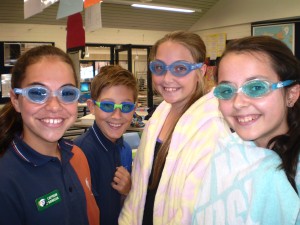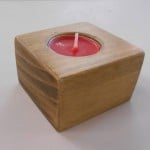Last week some of our year 5, 6 and 7 students travelled to another local school to compete in several sports, which were: girls soccer, netball, boys soccer, modcross and Aussie Rules football. To say we were successful would be an understatement as we actually won every game. I personally am the coach for the girls’ soccer team who won with a resounding 16 – 0 score. They were absolutely brilliant, despite getting soaked by a sudden torrential downpour. I’d like to say that, as the coach, the victory had something to do with my incredible coaching skills, but these girls would have won even if they’d never been coached by anyone. For a great write-up of the game check out Aimee’s blog and her post called Inter School Soccer. Well done to all the teams for such an amazing effort.
Month: May 2014
Swimming
The annual fortnight of swimming is upon us which means our usual timetable has taken a dive. Not that we’re going to complain; following a very intense run up to our NAPLAN testing, including a week of the tests themselves, a break from the serious business of school life comes just at the right time. Learning to swim is also an essential life skill, especially for a nation that enjoys spending their long hot summers at the beach or in the backyard pool. All in all, even though term two is pretty mixed up, it’s still going swimmingly!
What’s New?
Well, there’s plenty, really, I’ve just been so busy trying to ensure NAPLAN went well, starting reports and keeping the activities flowing that my blog has simply had to wait. Working days, evenings and weekends is just a teacher’s typical lot, but it can mean we get a little wrapped up at times.
Anyway, the list of new “stuff” (our term for the work we do) is quite substantial. We’ve started a couple of new Art projects, a class one and another in partnership with our inspirational Art specialist Ms Sveinbjornsson. Both involve photography, though I can’t yet divulge the details of the class project. However, Ms Svein has introduced the students to the wonderful work of Roy Lichtenstein and we are deep into our attempts to recreate his art using our own photos. As usual, I’ll post the results as soon as we have them.
In History we’re continuing our Roman theme and have recently watched a Time Team video to learn about the scientific process that the archaeologists follow in order to achieve accurate results. The students are using Google Drive to collaborate on their responses to the questions I set for them.
Geography is also plodding along with students using their knowledge from the first term to determine the liveability of a random suburb selected from the real estate papers. Using Google Maps, they look at the facilities in their suburb (schools, parks, public transport, location away from main roads, shops…) to determine its attractiveness to potential residents. They also use Google Maps to look at the images from street level. Although these are now some years old they still have use and add to the information the students collect.
Maths and English are back into normal mode (following NAPLAN test prep) and we can now get back to addressing the requirements of the Australian Curriculum. All in all we are getting back to our usual busy selves, learning, developing and having fun whilst we do it.
And Finally…
Finally, the waiting’s over! Mothers’ Day has finally been and gone. Until it was over and the gifts were delivered I couldn’t post the final instalment of the surprise the students had been making for their mums. If you’ve been following us you’ll remember how they’d been sawing and drilling some wood to make their gift. Well, the results were awesome and the lucky mums received their hand made candle holders last Sunday. They’d been sanded, waxed with an antique coloured wax and then polished to create that final sheen. The photo’s below show two examples of the fabulous, finished products. I’m sure you’ll agree, they did a great job.
Blast From The Past
This week I’m going to take a leaf out of the book that the major television networks seem to operate from and show a repeat post. This isn’t because the news from our classroom is a bit thin on the ground (NAPLAN…), it’s actually a perfect opportunity to show the students in my current class how to produce a clear, interesting and entertaining podcast. It will also give me an opportunity to demonstrate a few of the uses for podcasts in the classroom. Also, a few of the schools in our local area are interested in producing podcasts and this will give a bit of an explanation as to why I use them.
The first one was made by Holly and shows how podcasting can be introduced to the Pre-Primaries. It was a simple example of students presenting their news in a format that their parents can listen to on the blog. Also, it gave Holly an opportunity to demonstrate her great interpersonal skills. The second shows how podcasts can be used to allow students to demonstrate their understanding of a topic, in this case post traumatic stress disorder (a topic from or studies of the Vietnam War). The final one is a discussion where students chat informally about their opinions on a quite personal topic (this was a deep topic but it tied in with a learning programme we were doing). This type of podcast still relies on the formalities of turn taking and expression, rather than just playground type speech.
Blogging Task #3
Do you have a favourite factual or lifestyle programme? The task this time is to write a post about one such programme. Factual and lifestyle programmes both entertain and enlighten us and can be amongst the best programmes on television.
My favourite (even though this does tend to change depending on what’s on tv at the time) is COSMOS: A Spacetime Odyssey with the amazing scientist Neil deGrasse Tyson. The programme was originally aired in 1980 with Carl Sagan, but the ever changing nature of science and technology means that there has been many new discoveries since then. Tyson has explained (amongst so many things) about the laws of physics which are evident and constant throughout the universe and also the evidence that underpins our understanding of evolution. His ability to demonstrate complex scientific concepts in an entertaining and easy to understand style makes this programme an absolute MUST SEE for anyone with an open mind to the type of science that explains and proves our understanding of the universe, who we are and where we came from.
Importance of Student Blogging
I’ve always been a firm believer in the usefulness of incorporating blogs (and other technology) into the classroom, but it’s sometimes been a little difficult to get others to understand my enthusiasm about giving students real world experiences with digital technologies. In a recent podcast, on Every Classroom Matters, entitled An Educator’s Guide to the Emerging, Expanding View of Digital Citizenship, Anne Collier, a member of the UN Internet Governors Forum and a Facebook Safety Advisory Board member, talks about the importance of students being actively involved in their digital environment. She believes we can’t simply tell students how to use digital media or how to be safe in the digital world. A lesson plan or a worksheet just won’t do it; living and experiencing digital media is the only way to develop understanding and skill. The analogy she uses is that it’s like teaching cooking without actually being in the kitchen. We need to allow students to participate responsibly in order to develop self-governance in their online lives. One of the best ways to do this is to allow students to use a blog to communicate with others around the world. Have a listen to this short (10 minute) podcast to hear how the things we are doing in LA19 are in line with research based theories of best practice in digital, experiential learning.




